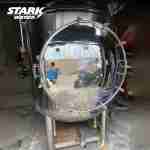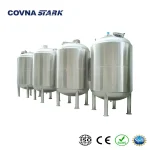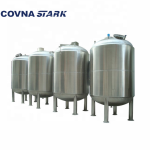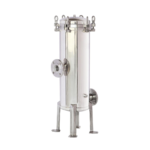Stainless steel mixing tanks play a critical role in industries where hygiene, durability, and precise processing are essential—such as water treatment, food and beverage, pharmaceutical manufacturing, and chemical blending. These tanks ensure homogeneous mixing, thermal stability, and contamination-free handling of liquids.
To get the best performance and longest lifespan from your STARK stainless steel mixing tank, it's essential to follow correct usage procedures and implement a regular maintenance routine. In this guide, we’ll walk you through key operational practices, cleaning tips, and long-term care strategies to keep your tank functioning at peak condition.
Key Steps Before First Use
Before putting your stainless steel mixing tank into operation, it's essential to conduct a proper inspection and perform initial cleaning. This ensures both operational safety and product quality from the very first batch.
1. Visual and Structural Inspection
- Inspect the internal surface for cleanliness. It should be free of welding residue, scratches, or discoloration.
- Check all inlets, outlets, manholes, and sensor ports to confirm that gaskets are properly seated and no damage has occurred during transport.
- Ensure that the agitator and impeller type match your intended fluid viscosity and mixing speed.
2. Leak and Pressure Testing
- If the tank was not tested on-site by the supplier, perform a static pressure test using clean water filled to 80–90% of total capacity.
- Observe all welded joints and fittings for any leaks or seepage over a 12–24 hour holding period.
3. Cleaning and Surface Conditioning
- Rinse the tank thoroughly with warm water and a food-grade neutral detergent to remove transport dust or oils.
- For critical applications, perform surface passivation using a diluted nitric or citric acid solution to restore stainless steel's corrosion-resistant oxide layer.
- After chemical treatment, rinse multiple times with RO or DI water until the pH returns to neutral.
4. Verify Operational Accessories
- Test sensors for temperature, level, and pressure to ensure accurate readings.
- Confirm that the agitator runs smoothly in the correct direction and speed. Check for proper alignment and vibration.
- Ensure that safety features such as emergency stops, overload protection, or access interlocks are functioning properly.
Following these procedures before initial use will help prevent costly damage, improve mixing efficiency, and ensure that your tank operates according to hygienic standards and technical specifications from the very start.
Daily Operation Best Practices
To ensure long-term performance and process consistency, it's important to follow industry-proven practices when operating a stainless steel mixing tank. Whether used for batch mixing, continuous blending, or thermal conditioning, the following guidelines apply across industries.
1. Pre-Operation Checklist
- Always confirm that the tank is clean and dry before introducing product materials.
- Verify that all valves and ports are closed or configured as needed for the process.
- Ensure that all connected systems—such as CIP, agitator motors, and sensors—are powered and calibrated correctly.
2. Loading and Mixing Guidelines
- Follow the recommended fill level (typically 70–90% of nominal capacity) to allow sufficient space for agitation and avoid spillage.
- Add solids and additives gradually to prevent clumping or shear damage.
- Use the correct impeller speed and type based on product viscosity. Avoid over-speeding, which may cause cavitation or damage seals.
3. Temperature and Pressure Monitoring
- Ensure that the operating temperature is within the specified range (usually -20°C to 150°C for SUS316 tanks).
- If using a jacketed tank, monitor the temperature differential to prevent thermal shock to the tank wall.
- Watch for any abnormal pressure changes that could indicate valve blockages or over-agitation.
4. Post-Use Protocol
- Drain residual product completely using the bottom outlet or sloped design.
- Flush the tank with warm water immediately after use to prevent material drying or scaling.
- Log operating hours and performance data to assist with maintenance tracking.
By following these daily practices, you can optimize mixing efficiency, reduce product loss, and extend the operational lifespan of your STARK stainless steel mixing tank.
Cleaning & CIP Guide
Regular and effective cleaning is essential to maintain hygiene, prevent cross-contamination, and prolong the service life of a stainless steel mixing tank. Depending on your industry and product type, STARK tanks support both manual cleaning and automated Clean-in-Place (CIP) procedures.
1. Manual Cleaning Procedure
- Drain all residual product from the tank through the bottom outlet or slope outlet port.
- Rinse the interior walls using warm water to loosen any remaining material or buildup.
- Scrub with a soft brush or sponge and a food-grade neutral detergent—avoid using abrasive pads or high-pH chemicals that may damage the polished surface.
- For sticky or protein-based residues, use an enzymatic or alkaline cleaner, followed by a neutralizing rinse.
- Rinse the tank thoroughly with potable or RO water until no detergent residue remains and pH is balanced.
2. CIP (Clean-in-Place) Procedure
- Install or activate a 360° rotary spray ball or static spray nozzle within the tank (typically mounted on the top dome or cover).
- Circulate hot water or a chemical solution (such as caustic soda at 0.5–1.0%) for 10–20 minutes at 60–80°C, depending on residue type.
- Conduct an acid rinse (e.g., nitric acid at 0.3–0.5%) for passivation and biofilm prevention.
- Conclude with a clean water flush (DI or RO preferred) until conductivity and pH return to baseline.
- Optional: Use SIP (Steam-in-Place) at ≥121°C for sterile-grade environments like pharmaceutical or cosmetics processing.
3. Cleaning Frequency Recommendations
- Food-grade and cosmetics applications: after every batch or shift
- Water treatment or industrial blending: every 2–3 cycles or weekly
- Pharmaceutical: according to GMP protocol or validated cleaning schedule
Proper cleaning not only ensures product safety but also maintains the corrosion resistance and mechanical integrity of the tank. STARK recommends maintaining a validated cleaning log as part of your SOP (Standard Operating Procedures) for full traceability.
Maintenance Schedule & Common Issues
To ensure consistent performance and minimize downtime, your stainless steel mixing tank should follow a structured maintenance plan. STARK mixing tanks are designed for durability, but like any precision equipment, proactive care prevents costly repairs and process interruptions.
Recommended Maintenance Schedule
| Frequency | Maintenance Task |
|---|---|
| Daily | Rinse and drain tank after each use, inspect for visible residue or corrosion |
| Weekly | Check agitator operation, vibration levels, gasket condition, and sealing performance |
| Monthly | Inspect all valves, connections, and manholes for leaks or mechanical wear |
| Quarterly | Lubricate motor shafts (if applicable), calibrate sensors, clean CIP spray nozzles |
| Annually | Conduct pressure testing, replace worn gaskets, perform full mechanical inspection |
Common Issues and Troubleshooting
- Agitator misalignment or vibration: Check shaft coupling, impeller imbalance, and mount stability.
- Leaks at connections or manhole covers: Inspect gasket wear, improper torque, or surface scratches.
- Inconsistent mixing: Verify that impeller type and speed are appropriate for batch viscosity and volume.
- Surface discoloration: May be due to chemical incompatibility or lack of passivation—clean and repassivate if needed.
- CIP effectiveness drops: Clean spray nozzles, check for clogging, increase flow rate or temperature if required.
Maintaining a regular maintenance log and conducting predictive checks will help extend your tank’s operating life beyond 10–15 years with minimal performance degradation. STARK engineering teams are also available for on-site inspections and replacement part support worldwide.
Conclusion: Reliable Operation Starts with Smart Usage
Whether you're blending process water, chemical solutions, or food-grade ingredients, the long-term performance of a stainless steel mixing tank depends on proper use, consistent cleaning, and scheduled maintenance. By following the best practices outlined in this guide, you’ll not only preserve the hygienic and mechanical integrity of your tank but also reduce operational risks and increase product quality.
At STARK, we combine precision engineering with field-tested durability to bring you fully customizable mixing tanks that meet global standards for safety and performance. Our tanks are used across industries—from pharmaceuticals to wastewater treatment—and we’re here to support your team at every stage, from design consultation to after-sales care.
Ready to invest in a tank built to last? Learn more about our customizable stainless steel mixing solutions here:
STARK Customized Stainless Steel Mixing Water Tank
Need expert advice for your application? Contact our engineering team today for personalized guidance and a competitive quote.





